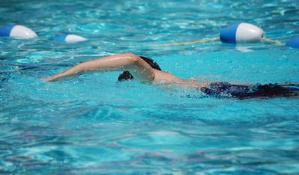SWIMMING
 Whatever your age or fitness levels swimming is an excellent fitness and weight loss program. Swimming is especially useful for those people with physical limitations that keep them from engaging in other forms of exercise. It is a low impact exercise, easy on the joints and bones.
Whatever your age or fitness levels swimming is an excellent fitness and weight loss program. Swimming is especially useful for those people with physical limitations that keep them from engaging in other forms of exercise. It is a low impact exercise, easy on the joints and bones.
When you immerse yourself halfway in water, your body carries only 50% of its weight and if the water goes up to your neck, you carry only 10% of your weight. That’s the reason why swimming is used for rehabilitating injured people and people with some disabilities.
The best place to get started as a swimmer is your local pool were you can enquire about swimming classes for beginners or whichever level that you feel comfortable to start in. There may even be women only classes available.
SWIMMING STYLES
There are a variety of swimming styles and each works differently and benefits different muscle groups.
Freestyle or front crawl is a swimming style where you keep your body as straight as possible, alternate arm movements and kick your legs as hard as you can. It is the most popular swimming style because it’s the fastest. The biggest challenge for beginners to this swimming style is breathing technique which affects the execution of the strokes.
Freestyle works the chest, back, lats and the neck and arm muscles.
Here are a few breathing tips to help you in the freestyle.
- Don’t hold your breath even when your face is under water. Exhale continuously by blowing out bubbles.
- Don’t lift your head to breathe rather breathe through the bow wave that your head and your body create and you won’t need to lift your head.
- Don’t rotate your head when breathing as it will cause you to lose balance and you may topple to the side.
Backstroke is similar to the freestyle except that you’re floating on your back. You achieve movement by kicking your legs (flutter kick) and moving your arms using alternate pulls. The backstroke works out the back as well as your hamstrings. Balancing on your back without tilting to your side is the key to a good backstroke technique.
The backstroke can be performed at quite a leisurely pace.
The butterfly requires that the arms move simultaneously over the head and into the water. The legs also move together and make a circular kick similar to the way a dolphin kicks. The butterfly works out the abdominal and lower back muscles.
This one is quite a physical workout and may take some practice.
The breast stroke uses a kick similar to a frog where the swimmer bends their legs at the knees and then kicks out. The arms then make a heart shaped pattern and return to the chest for the next movement. This stroke is wonderful for cardiovascular workout and also targets the shoulder and chest muscles.
BASIC EQUIPMENT REQUIRED FOR SWIMMING
- A swimsuit is the first essential. For men shorts or trunks are fine while women can choose between various full length specifically designed outfits that are available these days. What you’re comfortable wearing is the best pick.
- A swimming cap is important to keep your hair from getting into your face and also to prevent hair getting into the swimming pool.
- Swimming goggles protect your eyes from chlorine irritation and also stop water from getting into your eyes. They allow for better visibility when you’re under water.
- For people who are prone to ear infections, it is prudent to buy ear plugs which will prevent water from entering your ears.
THE BENEFITS OF SWIMMING
 Swimming is a low impact type of exercise which can be enjoyed for a lifetime irrespective of your age because it does not hurt the joints or cause pain. Old and young people alike can enjoy the benefits of a good swim.
Swimming is a low impact type of exercise which can be enjoyed for a lifetime irrespective of your age because it does not hurt the joints or cause pain. Old and young people alike can enjoy the benefits of a good swim.
- When injured and you want to maintain your fitness levels, swimming is the best choice for exercise as it will not cause further injury but will strengthen your body and even help you to heal faster.
- You get more toned and build your muscles. Swimming works out different muscle groups and over several weeks you will notice that your muscles will start being defined and gain strength.
- Swimming is an activity that the whole family can enjoy with the added benefit of working out the body. It’s a fun activity for children as well as for adults and as the children play in the pool you can get in your swimming workout.
- Swimming improves your flexibility by moving every part of your body like your arms, legs, and your neck to create overall flexibility. When swimming you tend to stretch your body for different strokes and this too improves flexibility by lengthening your body.
- Swimming is an aerobic exercise that targets the heart. By making your heart pump blood faster it strengthens it and ensures proper blood flow to all parts of the body. Swimming makes your heart healthier and protects you from heart disease. When the blood flows rapidly through the body it stretches your arteries which are usually at risk of narrowing.
- Swimming helps you to burn calories. The number of calories you can burn will depend on the intensity of your strokes and the time distance of your laps. Start slow and gradually increase the number of laps that you do. Alternate with rest and soon you will see the physical results in the form of burning calories leading to better shape, posture and fitness.
- People prone to asthma attacks can comfortably swim because the conditions in the swimming pool are moist and they reduce asthma symptoms. Studies have shown that swimmers who are asthmatic show a decrease in the severity of their symptoms and in the number of times that they have to be hospitalised.
- Swimming raises HDL levels. HDL is the good cholesterol that the body needs and increasing it helps to flush out the bad cholesterol. A decrease in bad cholesterol lowers your chances for contracting heart disease.
- Swimming is a relaxing form of exercise more so than the gym or even running. Swimming releases endorphins which are the chemicals that make you feel good. It also keeps depression at bay by improving your self-image and also releasing tension and stress.
